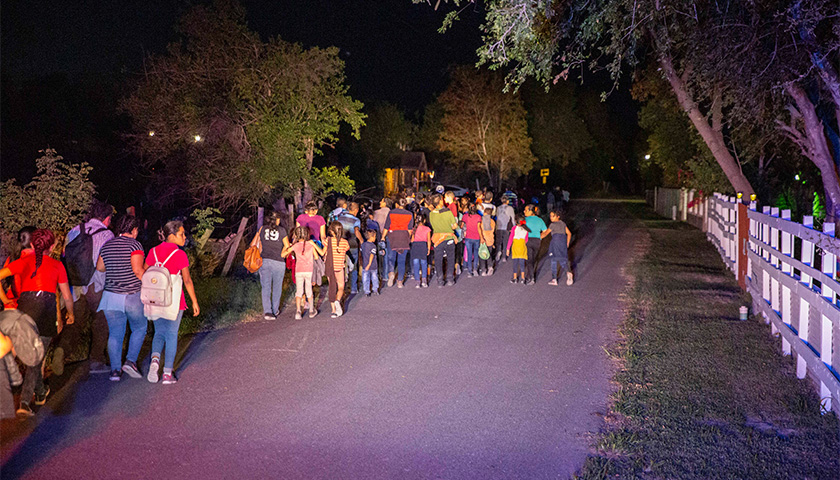by Bethany Blankley
Roughly six weeks before testifying Tuesday before the House Committee on Oversight and Accountability, Chief Border Patrol Agent Gloria Chavez held a meeting with local law enforcement in Weslaco, Texas, describing the administration’s plan to release en masse illegal foreign nationals into the U.S. when Title 42 ended.
The Biden administration sought to end Title 42, the public health authority first implemented under the Trump administration during the height of the pandemic, but Texas sued and in December a federal court prevented the administration from ending it.
Several people attending the Dec. 20 meeting recorded it and provided an audio copy to The Center Square on condition of anonymity for fear of retaliation by the administration. Chavez was gone for most of the briefing to take a phone call and two other long-term Border Patrol agents gave presentations instead.
Chavez leads the Rio Grande Valley Sector in Texas, one of the most heavily trafficked areas. At the time, agents in all nine southern border sectors were encountering more than 50,000 foreign nationals at the border a week, she said.
Border Patrol agents in December were averaging taking 15,000 illegal foreign nationals into custody every day, she said, with some sectors at 150% capacity.
“There is an expectation that we will be seeing an increase in flow and parole” in the RGV Sector, she said. The sector was also receiving roughly 20 flights and eight busloads a week of illegal foreign nationals from Yuma, Arizona, and El Paso and Del Rio in Texas because its facilities can hold more people.
Border Patrol apprehensions and reported gotaways in December were the highest in U.S. history with more than 300,000, according to data obtained by The Center Square.
At the Dec. 20 meeting, one of the border agents said “everything has changed in the last two years. Over the past two years the entire landscape has changed, not only with the entries but the demographics and types of people who are exploiting the immigration process,” according to the audio recording obtained by The Center Square.
Because of the volume of people coming in, the agent said, “more folks get processed for release because we just can’t sustain it.” Holding facilities were over 100% capacity in Del Rio, El Paso, Yuma and El Centro, the agent said. Four of nine southwest border sectors were in the red, closer to 150% capacity, he said.
This includes the highest number of Cubans and Nicaraguans in custody in U.S. history, he said, asking, “How do you apprehend more Cubans than you do Mexicans?” They found that Cubans are flying to Mexico to cross the southwest border to claim asylum because when they arrive in Florida, they are deported.
“From 2021 to fiscal 2022 there are cities in Mexico where people say they are going to go to find smugglers who charge less to bring them across the Rio Grande River,” he said, noting that “Texas has the greatest traffic of gotaways.”
Single, military-age men make up 70% of illegal entries, which are harder to deal with because of safety concerns, he said. They are seeing armed individuals – 17 Border Patrol agents were assaulted last year, “the highest [number] we’ve ever seen,” he said.
By the spring, all aerostats, balloons with surveillance capabilities, won’t be operational because they are no longer being funded, he said. They’ve acted as vital “force multipliers,” he said, helping agents track gotaways and other interdiction efforts.
When the “Mexican side knows they are up,” he said, “activity drops.” With no aerostat in the air, the cartels will have greater capability to evade law enforcement.
The agent also said the “choice drug” coming through the southern border “is illicit fentanyl,” with the highest volumes being seized in RGV Sector, followed by largest liquid meth seizure of 3,000 pounds last year.
In response to one participant asking who was transporting illegal foreign nationals north in buses and stopping at local gas stations in local communities and letting people out, Lozie said it was their nongovernmental organization (NGO) partners. However, he added, “There needs to be better coordination from the NGOs back to Border Patrol to let us know where they are dropping them off.” Once they are released into the U.S., there’s no tracking mechanism to know where they are.
The agent also told law enforcement that there’s “no way border patrol can get through this without you,” thanking them for being partners with BP agents. He also said the agency was “working with resiliency to deal with multiple suicides; one in Brownsville, two in Corpus and another in the Weslaco area. We’ve never seen suicides [among Border Patrol agents] at this pace before.
“If you see an agent, know an agent, give them a pat on the back, they need our support now more than ever before.”
After returning, Chavez closed the briefing by saying she was coordinating with local mayors and NGOs to move people into the U.S., saying the NGOs “are phenomenal.” She was learning of “particular areas they [the counties] want us to drop them off at,” referring to those being released into the U.S. by the Biden administration.
Chavez is testifying Tuesday before the U.S. House Committee on Oversight and Accountability.
– – –
Bethany Blankley is a contributor to The Center Square.
Photo “A Large Group of Migrants” by U.S. Customs and Border Protection.





